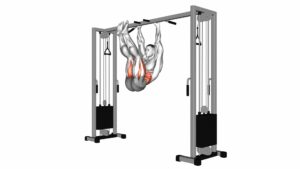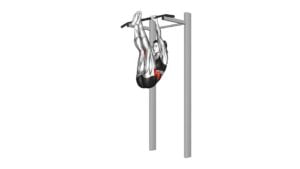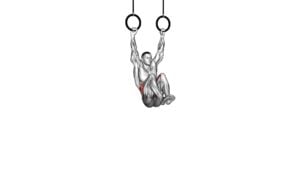Hanging Leg Hip Raise – Video Exercise Guide & Tips

Are you looking for an effective way to strengthen your core and sculpt your abs? Look no further than the hanging leg hip raise.
Watch This Exercise Video
This exercise targets your lower abs and hip flexors, helping you achieve a toned and defined midsection.
With just a pull-up bar and a few minutes of your time, you can start reaping the benefits of this challenging move.
In this video exercise guide, we'll show you the proper form, tips for increasing difficulty, and common mistakes to avoid.
Let's get started!
Key Takeaways
- The hanging leg hip raise targets lower abdominal muscles and improves core stability and balance.
- It activates hip flexors, glutes, and lower back muscles, promoting better posture and reducing the risk of lower back pain.
- The exercise builds core strength, improves hip mobility, and enhances overall stability.
- The hanging leg hip raise can be modified for different fitness levels and there are various progressions and variations that can be incorporated.
Benefits of the Hanging Leg Hip Raise
You can experience several benefits from performing the Hanging Leg Hip Raise. This exercise primarily targets your lower abdominal muscles, helping to strengthen and tone them. By engaging your core, you also improve your overall stability and balance.
Additionally, the Hanging Leg Hip Raise activates your hip flexors, glutes, and lower back muscles, promoting better posture and reducing the risk of lower back pain.
Another benefit of this exercise is its versatility. There are several variations that you can incorporate to target different muscle groups and increase the challenge. For instance, you can try the Hanging Straight Leg Raise, where you keep your legs straight throughout the movement, intensifying the workout for your abs and hip flexors. Alternatively, you can perform the Hanging Knee Raise, bending your knees and bringing them towards your chest, which puts more emphasis on your lower abs.
Now that you know about the benefits and variations of the Hanging Leg Hip Raise, let's move on to the equipment needed for this exercise.
Equipment Needed for the Exercise
To perform the Hanging Leg Hip Raise, you'll need a pull-up bar or a set of parallel bars. These pieces of equipment are essential for properly executing the exercise and targeting your core muscles effectively. Here are some types of equipment and alternatives you can consider:
- Pull-up bar: This is the most common and convenient option for performing Hanging Leg Hip Raises. It can be easily installed in a doorway or attached to a sturdy structure, providing a stable platform for the exercise.
- Parallel bars: These are a great alternative if you don't have access to a pull-up bar. Parallel bars are typically found in gyms or outdoor fitness parks and offer a different grip and range of motion options.
- Power tower: A power tower is a versatile piece of equipment that combines a pull-up bar with parallel bars. It provides additional stability and support, making it suitable for beginners or individuals with limited upper body strength.
- Suspension trainer: If you prefer a portable and versatile option, a suspension trainer can be used to perform Hanging Leg Hip Raises. It utilizes straps and handles that can be attached to a sturdy anchor point, such as a door frame or a tree branch.
Now that you know the equipment options, let's move on to the next section and learn about the proper form and technique for the Hanging Leg Hip Raise.
Proper Form and Technique for the Exercise
To perform the Hanging Leg Hip Raise with proper form and technique, focus on engaging your core muscles and maintaining control throughout the exercise. This exercise primarily targets the lower abs and hip flexors, so it's important to execute it correctly to maximize its benefits and avoid potential injuries.
One common mistake is using momentum to swing your legs up instead of relying on your core strength. Remember to initiate the movement from your abs, lifting your legs up in a controlled manner. Avoid relying on your hip flexors to do the work.
Another common mistake is arching your back excessively during the exercise. This not only reduces the effectiveness of the exercise but also puts unnecessary strain on your lower back. Instead, focus on keeping your core engaged and your back flat against the bench or hanging apparatus.
Maintaining proper breathing is also crucial. Exhale as you lift your legs up and inhale as you lower them down. This helps to engage your core muscles and maintain stability throughout the exercise.
Tips to Increase the Difficulty of the Exercise
To increase the difficulty of the exercise, incorporate weighted ankle cuffs or ankle weights. Adding extra weight to your legs will challenge your muscles even more, making the hanging leg hip raise a more advanced exercise. Here are some tips to increase the difficulty and take your workout to the next level:
- Use weighted ankle cuffs: Strap on ankle cuffs that have built-in weights. These cuffs will add resistance to your leg movements, making the exercise more challenging.
- Try ankle weights: If you don't have access to ankle cuffs, you can use ankle weights instead. Simply strap them around your ankles before starting the exercise.
- Increase the weight gradually: Start with a lighter weight and gradually increase as you get stronger. This will allow your muscles to adapt and grow over time.
- Explore advanced variations: Once you have mastered the basic hanging leg hip raise, you can try advanced variations such as the hanging windshield wiper or the hanging leg raise with a twist. These variations target different muscles and add an extra challenge to your workout.
Remember, it's important to listen to your body and not push yourself too hard. If you feel any pain or discomfort, stop the exercise and consult with a fitness professional.
Additionally, if the hanging leg hip raise is too difficult for you, there are alternative exercises you can try, such as the lying leg raise or the captain's chair leg raise. These exercises work similar muscle groups and can be modified to suit your fitness level.
Common Mistakes to Avoid During the Exercise
Avoiding common mistakes is crucial when performing the hanging leg hip raise exercise. To ensure you get the most out of this exercise, it's important to be aware of the common pitfalls and how to avoid them.
One mistake to avoid is improper breathing. Many people hold their breath or breathe shallowly during the exercise, which can decrease oxygen flow and make the exercise less effective. Remember to breathe deeply and exhale as you lift your legs.
Another mistake to watch out for isn't maintaining proper form. It's important to keep your core engaged and your back straight throughout the exercise. Avoid arching your back or swinging your legs, as this can put unnecessary strain on your lower back and reduce the effectiveness of the exercise.
Lastly, be cautious of attempting advanced variations or modifications before you have mastered the basic form. It's important to gradually progress and build strength before attempting more challenging variations. Starting with the basic hanging leg hip raise and gradually increasing difficulty will help you avoid injury and get the most out of the exercise.
Frequently Asked Questions
How Many Calories Does the Hanging Leg Hip Raise Burn?
The hanging leg hip raise is a great exercise for burning calories and targeting your core muscles. When performed correctly, it can help you burn a significant amount of calories. However, the exact number of calories burned will vary depending on factors such as your weight, intensity of the exercise, and duration.
If you're a beginner, don't worry! There are modifications available to make this exercise more manageable and help you gradually build strength.
Is It Safe to Perform the Hanging Leg Hip Raise if I Have Lower Back Pain?
If you're experiencing lower back pain, it may not be safe to perform the hanging leg hip raise. It's important to listen to your body and avoid exercises that exacerbate your pain.
However, there are alternative exercises and modifications you can try that target similar muscle groups without putting strain on your lower back. Consult with a fitness professional or physical therapist to find the best options for you.
Can I Do the Hanging Leg Hip Raise if I Don't Have Access to a Pull-Up Bar?
If you don't have access to a pull-up bar, there are alternative exercises you can do to work your hip muscles. Look for exercises that target similar muscle groups, such as hanging knee raises using a captain's chair or a Roman chair.
These modifications can be effective in strengthening your hips without the need for a pull-up bar. Remember to consult with a fitness professional to ensure proper form and technique.
How Long Should I Hold the Peak Contraction Position During the Hanging Leg Hip Raise?
During the hanging leg hip raise, it's important to focus on the peak contraction position and maintain proper form.
To answer your question, the duration of the peak contraction position should be around 1-2 seconds. This ensures that you engage your hip flexors and abdominal muscles effectively.
Remember to keep your legs straight and control the movement throughout.
Are There Any Alternative Exercises That Target the Same Muscle Group as the Hanging Leg Hip Raise?
If you're looking for alternative exercises that target the same muscle group as the hanging leg hip raise, there are a few options you can try.
Some alternatives include hanging knee raises, captain's chair leg raises, and lying leg raises.
These exercises all work your abdominal muscles and can provide a similar challenge to the hanging leg hip raise.
Remember to focus on proper form and engage your core muscles throughout the movement for maximum benefit.
Conclusion
In conclusion, the hanging leg hip raise is a beneficial exercise that targets the core muscles and improves hip flexibility.
To perform this exercise, you'll need a bar or rings to hang from. It's important to maintain proper form and technique, engaging the abs and lifting the legs until they reach hip height.
By following these tips and avoiding common mistakes, you can increase the difficulty of the exercise and maximize its effectiveness.

Author
Years ago, the spark of my life’s passion ignited in my mind the moment I stepped into the local gym for the first time. The inaugural bead of perspiration, the initial endeavor, the very first surge of endorphins, and a sense of pride that washed over me post-workout marked the beginning of my deep-seated interest in strength sports, fitness, and sports nutrition. This very curiosity blossomed rapidly into a profound fascination, propelling me to earn a Master’s degree in Physical Education from the Academy of Physical Education in Krakow, followed by a Sports Manager diploma from the Jagiellonian University. My journey of growth led me to gain more specialized qualifications, such as being a certified personal trainer with a focus on sports dietetics, a lifeguard, and an instructor for wellness and corrective gymnastics. Theoretical knowledge paired seamlessly with practical experience, reinforcing my belief that the transformation of individuals under my guidance was also a reflection of my personal growth. This belief holds true even today. Each day, I strive to push the boundaries and explore new realms. These realms gently elevate me to greater heights. The unique combination of passion for my field and the continuous quest for growth fuels my drive to break new ground.







